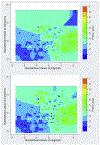Drug use-related stigma, safer injection norms, and hepatitis C infection among a network-based sample of young people who inject drugs
- PMID: 33689967
- PMCID: PMC8041355
- DOI: 10.1016/j.drugalcdep.2021.108626
Drug use-related stigma, safer injection norms, and hepatitis C infection among a network-based sample of young people who inject drugs
Abstract
Background: Identifying risk for hepatitis C (HCV) infection is important for understanding recent increases in HCV incidence among young people who inject drugs (PWID) in suburban and rural areas; and for refining the targeting of effective HCV preventive interventions. Much of the extant research has focused on individual health behaviors (e.g., risky drug injection behaviors) as predictors of HCV infection. The present study examines two social factors (substance use-related stigma and injection-related social norms), and the interaction between these factors, as predictors of HCV infection.
Methods: Baseline data were used from an ongoing longitudinal study of young PWID (N = 279; mean age = 30.4 years) from the Chicago suburbs and their injection risk network members. Adjusted logistic regression models were used to examine relationships among substance use-related stigma, safer injection norms, and HCV infection.
Results: Despite a marginal bivariate association between less safe injection norms and HCV infection (OR = 0.74; 95 % CI[0.39, 1.02]; p = .071), a significant stigma X norms interaction (AOR = 0.68; 95 % CI[0.51, 0.90]) suggested that at high levels of stigma, probability of HCV infection was high regardless of injection norms.
Conclusions: Findings suggest that social factors - specifically, substance use-related stigma and injection norms - are important predictors of HCV infection risk. The interaction found between these social factors suggests that intervening only to change injection norms or behaviors is likely insufficient to reduce risk for HCV infection in high-stigma settings or among high-stigma populations. Future research should develop and evaluate stigma-reduction interventions in combination with safer-injection interventions in order to maximize HCV risk reduction.
Keywords: Drug use-related stigma; Hepatitis C; Injection norms; Young people who inject drugs.
Copyright © 2021 Elsevier B.V. All rights reserved.
Conflict of interest statement
Figures
Similar articles
-
Drug use stigma and its association with active hepatitis C virus infection and injection drug use behaviors among community-based people who inject drugs in India.Int J Drug Policy. 2021 Oct;96:103354. doi: 10.1016/j.drugpo.2021.103354. Epub 2021 Jul 8. Int J Drug Policy. 2021. PMID: 34247900 Free PMC article.
-
The role of social networks and geography on risky injection behaviors of young persons who inject drugs.Drug Alcohol Depend. 2015 Sep 1;154:229-35. doi: 10.1016/j.drugalcdep.2015.06.042. Epub 2015 Jul 3. Drug Alcohol Depend. 2015. PMID: 26169447 Free PMC article.
-
Egocentric network characteristics of people who inject drugs in the Chicago metro area and associations with hepatitis C virus and injection risk behavior.Harm Reduct J. 2022 Jun 2;19(1):58. doi: 10.1186/s12954-022-00642-4. Harm Reduct J. 2022. PMID: 35655222 Free PMC article.
-
Young Drug Users: a Vulnerable Population and an Underutilized Resource in HIV/HCV Prevention.Curr HIV/AIDS Rep. 2018 Aug;15(4):324-335. doi: 10.1007/s11904-018-0406-z. Curr HIV/AIDS Rep. 2018. PMID: 29931468 Free PMC article. Review.
-
Barriers and enablers to testing for hepatitis C virus infection in people who inject drugs - a scoping review of the qualitative evidence.BMC Public Health. 2023 Jun 1;23(1):1038. doi: 10.1186/s12889-023-16017-8. BMC Public Health. 2023. PMID: 37259073 Free PMC article.
Cited by
-
Extent and implications of omitted ties on network measures in a longitudinal social network survey of people who use drugs.Drug Alcohol Depend. 2022 Sep 1;238:109554. doi: 10.1016/j.drugalcdep.2022.109554. Epub 2022 Jul 4. Drug Alcohol Depend. 2022. PMID: 35850026 Free PMC article.
-
Developing practical strategies to reduce addiction-related stigma and discrimination in public addiction treatment centers: a mixed-methods study protocol.Addict Sci Clin Pract. 2024 May 16;19(1):40. doi: 10.1186/s13722-024-00472-8. Addict Sci Clin Pract. 2024. PMID: 38755676 Free PMC article.
-
Drug use stigma and its association with active hepatitis C virus infection and injection drug use behaviors among community-based people who inject drugs in India.Int J Drug Policy. 2021 Oct;96:103354. doi: 10.1016/j.drugpo.2021.103354. Epub 2021 Jul 8. Int J Drug Policy. 2021. PMID: 34247900 Free PMC article.
-
Spatial inequities in access to medications for treatment of opioid use disorder highlight scarcity of methadone providers under counterfactual scenarios.medRxiv [Preprint]. 2023 Nov 8:2023.05.12.23289915. doi: 10.1101/2023.05.12.23289915. medRxiv. 2023. Update in: PLoS Comput Biol. 2024 Jul 26;20(7):e1012307. doi: 10.1371/journal.pcbi.1012307. PMID: 37292847 Free PMC article. Updated. Preprint.
-
Conceptualizing the Socio-Built Environment: An Expanded Theoretical Framework to Promote a Better Understanding of Risk for Nonmedical Opioid Overdose Outcomes in Urban and Non-Urban Settings.J Urban Health. 2022 Aug;99(4):701-716. doi: 10.1007/s11524-022-00645-3. Epub 2022 Jun 7. J Urban Health. 2022. PMID: 35672547 Free PMC article.
References
-
- Brener L, Broady T, Cama E, Hopwood M, de Wit JBF, Treloar C, 2020. The role of social support in moderating the relationship between HIV centrality, internalised stigma and psychological distress for people living with HIV. AIDS Care. 32, 850–857. - PubMed
Publication types
MeSH terms
Grants and funding
LinkOut - more resources
Full Text Sources
Other Literature Sources
Medical


